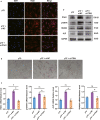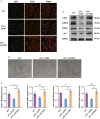p75NTR optimizes the osteogenic potential of human periodontal ligament stem cells by up-regulating α1 integrin expression
- PMID: 32424966
- PMCID: PMC7339167
- DOI: 10.1111/jcmm.15390
p75NTR optimizes the osteogenic potential of human periodontal ligament stem cells by up-regulating α1 integrin expression
Abstract
Human periodontal ligament stem cells (hPDLSCs) are a promising source in regenerative medicine. Due to the complexity and heterogeneity of hPDLSCs, it is critical to isolate homogeneous hPDLSCs with high regenerative potential. In this study, p75 neurotrophin receptor (p75NTR) was used to isolate p75NTR+ and p75NTR- hPDLSCs by fluorescence-activated cell sorting. Differences in osteogenic differentiation among p75NTR+ , p75NTR- and unsorted hPDLSCs were observed. Differential gene expression profiles between p75NTR+ and p75NTR- hPDLSCs were analysed by RNA sequencing. α1 Integrin (ITGA1) small interfering RNA and ITGA1-overexpressing adenovirus were used to transfect p75NTR+ and p75NTR- hPDLSCs. The results showed that p75NTR+ hPDLSCs demonstrated superior osteogenic capacity than p75NTR- and unsorted hPDLSCs. Differentially expressed genes between p75NTR+ and p75NTR- hPDLSCs were highly involved in the extracellular matrix-receptor interaction signalling pathway, and p75NTR+ hPDLSCs expressed higher ITGA1 levels than p75NTR- hPDLSCs. ITGA1 silencing inhibited the osteogenic differentiation of p75NTR+ hPDLSCs, while ITGA1 overexpression enhanced the osteogenic differentiation of p75NTR- hPDLSCs. These findings indicate that p75NTR optimizes the osteogenic potential of hPDLSCs by up-regulating ITGA1 expression, suggesting that p75NTR can be used as a novel cell surface marker to identify and purify hPDLSCs to promote their applications in regenerative medicine.
Keywords: cell surface marker; human periodontal ligament stem cells; osteogenic differentiation; regenerative medicine; signalling pathway.
© 2020 The Authors. Journal of Cellular and Molecular Medicine published by Foundation for Cellular and Molecular Medicine and John Wiley & Sons Ltd.
Conflict of interest statement
The authors confirm that there are no conflicts of interest.
Figures







Similar articles
-
PWAR6 interacts with miR‑106a‑5p to regulate the osteogenic differentiation of human periodontal ligament stem cells.Mol Med Rep. 2021 Apr;23(4):268. doi: 10.3892/mmr.2021.11907. Epub 2021 Feb 12. Mol Med Rep. 2021. PMID: 33576453 Free PMC article.
-
PERK-eIF2α-ATF4 signaling contributes to osteogenic differentiation of periodontal ligament stem cells.J Mol Histol. 2020 Apr;51(2):125-135. doi: 10.1007/s10735-020-09863-y. Epub 2020 Mar 2. J Mol Histol. 2020. PMID: 32124153
-
miR-23b mediates TNF-α-Inhibited Osteogenic Differentiation of Human Periodontal Ligament Stem Cells by Targeting Runx2.Int J Med Sci. 2021 Sep 9;18(16):3674-3683. doi: 10.7150/ijms.64312. eCollection 2021. Int J Med Sci. 2021. PMID: 34790039 Free PMC article.
-
A Review of Novel Strategies for Human Periodontal Ligament Stem Cell Ex Vivo Expansion: Are They an Evidence-Based Promise for Regenerative Periodontal Therapy?Int J Mol Sci. 2023 Apr 25;24(9):7798. doi: 10.3390/ijms24097798. Int J Mol Sci. 2023. PMID: 37175504 Free PMC article. Review.
-
Human periodontal ligament stem cells and hormesis: Enhancing cell renewal and cell differentiation.Pharmacol Res. 2021 Nov;173:105914. doi: 10.1016/j.phrs.2021.105914. Epub 2021 Sep 24. Pharmacol Res. 2021. PMID: 34563662 Review.
Cited by
-
Research progress of dental pulp regeneration treatment.Zhong Nan Da Xue Xue Bao Yi Xue Ban. 2024 Jun 28;49(6):989-997. doi: 10.11817/j.issn.1672-7347.2024.240011. Zhong Nan Da Xue Xue Bao Yi Xue Ban. 2024. PMID: 39311795 Free PMC article. Review. Chinese, English.
-
Analysis of the basement membrane-related genes ITGA7 and its regulatory role in periodontitis via machine learning: a retrospective study.BMC Oral Health. 2024 Dec 24;24(1):1548. doi: 10.1186/s12903-024-05201-w. BMC Oral Health. 2024. PMID: 39719569 Free PMC article.
-
Secretome Release During In Vitro Bone Marrow-Derived Mesenchymal Stem Cell Differentiation Induced by Bio-Oss® Collagen Material.Int J Mol Sci. 2025 Apr 17;26(8):3807. doi: 10.3390/ijms26083807. Int J Mol Sci. 2025. PMID: 40332455 Free PMC article.
-
Role of the GRP78-c-Src signaling pathway on osteoblast differentiation of periodontal ligament fibroblasts induced by cyclic mechanical stretch.Hua Xi Kou Qiang Yi Xue Za Zhi. 2024 Jun 1;42(3):304-312. doi: 10.7518/hxkq.2024.2023354. Hua Xi Kou Qiang Yi Xue Za Zhi. 2024. PMID: 39049649 Free PMC article. Chinese, English.
-
p75NTR antibody-conjugated microspheres: an approach to guided tissue regeneration by selective recruitment of endogenous periodontal ligament cells.Front Bioeng Biotechnol. 2024 Jan 31;12:1338029. doi: 10.3389/fbioe.2024.1338029. eCollection 2024. Front Bioeng Biotechnol. 2024. PMID: 38357709 Free PMC article.
References
-
- Trubiani O, Pizzicannella J, Caputi S, et al. Periodontal ligament stem cells: Current knowledge and future perspectives. Stem Cells Dev. 2019;28:995‐1003. - PubMed
-
- Seo B‐M, Miura M, Gronthos S, et al. Investigation of multipotent postnatal stem cells from human periodontal ligament. Lancet. 2004;364:149‐155. - PubMed
-
- Lei M, Li K, Li B, et al. Mesenchymal stem cell characteristics of dental pulp and periodontal ligament stem cells after in vivo transplantation. Biomaterials. 2014;35:6332‐6343. - PubMed
-
- Liu J, Zhao Z, Ruan J, et al. Stem cells in the periodontal ligament differentiated into osteogenic, fibrogenic and cementogenic lineages for the regeneration of the periodontal complex. J Dent. 2020;92:103259‐. - PubMed
Publication types
MeSH terms
Substances
LinkOut - more resources
Full Text Sources
Medical
Research Materials
Miscellaneous

